Japanese Visitors
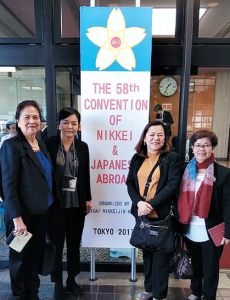 Sunday, October 22, 2017, in the afternoon, one of the PNJK officials Ms. Elizabeth Tagud joined the 3rd International Nikkei Karaoke Festival a singing contest held prior to the start of the convention. It was the first time for the Philippines to join the contest and with no rehearsal and alone Ms. Tagud received a special award
Sunday, October 22, 2017, in the afternoon, one of the PNJK officials Ms. Elizabeth Tagud joined the 3rd International Nikkei Karaoke Festival a singing contest held prior to the start of the convention. It was the first time for the Philippines to join the contest and with no rehearsal and alone Ms. Tagud received a special award
for her rendition of Teresa Teng’s “Toki no Nagare” with much gusto.
The “58th Kai Gai Nikkei Jin Tai Kai” or the Convention of Nikkei and Japanese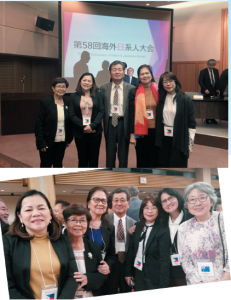 Abroad with the theme “Working together for Tokyo 2020!” was held on October 23–25, 2017, in Tokyo, Japan. The Davao delegation was headed by the Federation President Mallari, PNJK President Escovilla, PNJK Board members Ms. Apigo, Ms. Iwamoto, Ms. Tagud, and Ms. Kita while the Manila delegation by Nippi President
Abroad with the theme “Working together for Tokyo 2020!” was held on October 23–25, 2017, in Tokyo, Japan. The Davao delegation was headed by the Federation President Mallari, PNJK President Escovilla, PNJK Board members Ms. Apigo, Ms. Iwamoto, Ms. Tagud, and Ms. Kita while the Manila delegation by Nippi President
Buni, Nippi director Mr. Darauay, Mr. Garidan, and the Nakachi Family of Palawan. They were joined in Tokyo by JPIC President Tokumitsu and JPIC Coordinator Eve. A great number of participants came from the Philippines noting the presence of delegates from Davao and Manila Nippi Chapters.
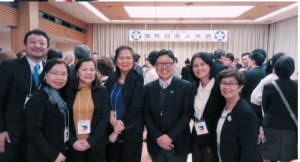
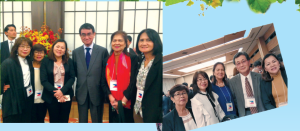
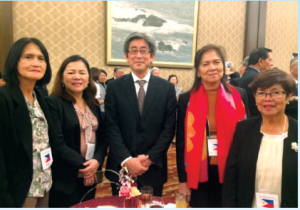 In the evening of the same date the delegates had a Fellowship Dinner hosted by JPIC. The dinner even became special as Atty. Kawai, Atty. Mochizuki, Mr. Inomata, and Ms. Ishii graced the event. Everyone was excited when Atty. Kawai announced that he is going to produce a movie about the descendants, those who are still active and well might be asked to play cameo roles to showcase the travails encountered by the Nikkei jins. The movie will be titled “Forgotten by the Japanese.” The evening became even livelier when Ms. Tagud was requested to sing her winning piece and accompanied by Mr. Sekino. All left sporting a happy mood despite the heavy downpour.
In the evening of the same date the delegates had a Fellowship Dinner hosted by JPIC. The dinner even became special as Atty. Kawai, Atty. Mochizuki, Mr. Inomata, and Ms. Ishii graced the event. Everyone was excited when Atty. Kawai announced that he is going to produce a movie about the descendants, those who are still active and well might be asked to play cameo roles to showcase the travails encountered by the Nikkei jins. The movie will be titled “Forgotten by the Japanese.” The evening became even livelier when Ms. Tagud was requested to sing her winning piece and accompanied by Mr. Sekino. All left sporting a happy mood despite the heavy downpour.
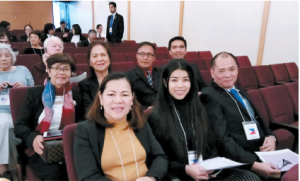 October 23, 2017, was the official opening of the convention at Kensei Kinenkan. A Welcome Party was hosted by the Imperial Family and attended by no less than their Royal Highness Prince Akishino and Princess Kiko.
October 23, 2017, was the official opening of the convention at Kensei Kinenkan. A Welcome Party was hosted by the Imperial Family and attended by no less than their Royal Highness Prince Akishino and Princess Kiko.
October 24, 2017, was the International Symposium. The topics for panel discussion were: @ Collaboration with the Nikkei Communities through Sports @ Nikkei Business Collaboration and @ What does “2020” mean for the Nikkei Youth. Some delegates opted to join the Official Tour but everyone gathered in the evening to attend the Welcome Reception hosted by the Minister for Foreign Affairs of Japan. The new minister H.E. Taro Kono gave an inspiring message. Afterwards the attendees were afforded with picture taking together with the good MOFA minister.
October 25, 2017, was the Announcement of the Conference Declaration. It was announced that the 59th Convention of Nikkei & Japanese Abroad will be held in Hawaii. It is also the 150th Anniversary of migration abroad. In commemoration of this, the 59th International Nikkei Competition will be held in Hawaii. “ALOHA.”
On the 3rd day of March 2017, at the Rizal Park, Davao City, PNJK-IS and MKD students presented Japanese Cultural number during the Pasundayag Night in time for the celebration of the 80th Araw ng Dabaw.
Watching the presentation, according to one who witnessed the show made her feel like she was back to Japan. Students wore colorful yukata walking in front of the audience just like any model that you see sporting various attire with colorful designs. There were students in cosplay costume doing a dance number.
The crowd likewise witnessed students dancing the Yosakoi- Solan that symbolizes the method or way of catching fish. The moves were synchronized that you can never believe that they practiced the steps on a limited time as it was difficult to choose who among the students could participate on the opening day of the Araw ng Dabaw.
Yet, they performed well and the steps were well executed.
PNJK-IS Music Consultant Shuji Honda San with JPVA Takakazu Machida San and Masanori Sukegawa San from Kidapawan Orphanage “ Easter Village” rendered a musical number. Honda san played his guitar while Machida san was with his violin and the piano by Sukegawa San.
The last was the best which is the Omikoshi and Taiko presentation. The manner by which the taiko is banged by the performer made one dumbfounded. One would wonder how much time was used in achieving such perfect move. So amazing that I agree with the statement that you seemed to have gone to Japan looking at the performers with colorful designs, music good to hear and performance excellently executed. We love to see once more Japanese cultural show if given the chance.
At about past ten in the morning of January 13, 2017, the party of Madam Akie Abe with Ms. Honeylet Avancena and Mrs. Medialdea arrived at the Mintal Memorial Garden. Madam Akie offered wreath and prayer before the monument known as Zairyu Senbou Douhou Irei Tou, the monument of those Japanese residents who died in the early days prior to the outbreak of World War II. The area was supposed to be the burial ground exclusively for the Japanese residents but after the war, so many Filipino residents destroyed the gravestones. Others were looking for the so-called “Yamashita treasure” such that the damage done was beyond repair. No treasure or any material of value was uncovered by unscrupulous person and/or the so-call treasure hunters.
After the offered prayer, Madam Akie and party were ushered to the Monument of No Regret which is the symbol of the long history of friendship between Japan and the Philippines. This is the monument donated personally by the then Mayor of the City of Davao, Hon. Mayor Rodrigo Roa Duterte.
Bishop Ajiro explained to Madam Akie Abe the reason behind the installation of the Monument of No Regret. Names of Kigyo Kyokai officials and benefactors headed by Datu Bago Awardee Tatsuo Uchida will be engraved in this monument. Madam Akie listened intently to what Bishop Ajiro was saying and with teary eyed, offered another prayer.
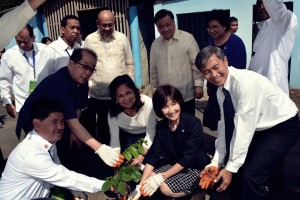 January 13, 2017, in the crowd gathered at the Mintal Public Cemetery, specifically at the area where Japanese tombs stand was the presence of persons in white polo shirt and dark pants. We assumed that these are the staffs assigned to safeguard the safety of the highest official in Japan.
January 13, 2017, in the crowd gathered at the Mintal Public Cemetery, specifically at the area where Japanese tombs stand was the presence of persons in white polo shirt and dark pants. We assumed that these are the staffs assigned to safeguard the safety of the highest official in Japan.
First to arrive was the group of Madam Yuko Ishikawa, the wife of the JapaneseAmbassador to the Philippines, His Excellency Ambassador Kazuhide Ishikawa. Introduction to various officials who were around took place. Bishop Masataka Ajiro the former President of the Japan Philippine Volunteer Association approached Madam Yuko to do the honor of the ceremonial narra tree planting right beside the road from the entrance of the cemetery to the area where Japanese tombs are found.
Assisting Madam Yuko in the tree planting ceremony were Bishop Ajiro, PNJKPresident Ret. Judge Antonina B. Escovilla, Barangay Captain Ramon Bargamento and PNJK 2nd Vice President Juseven Austero.
Hon . Consul Shiro Furihata of The Ministry of Foreign Affair in coordination with the Philippine Nikkei Jin Kai Legal Support Center headed by Mr. Inomota, Norihiro together with The Nippon Foundation represented by Ms. Ikuko Okubo came to Davao City, purposely to interview members of the Philippine Nikkei Jin Kai, Inc. (PNJK) Davao City Chapter.
This is one project that started last year involving the Ministry of Foreign Affair. In year 2015, Philippine Nikkei Jin Kai Rengokai headed by Mrs. Ines P. Mallari together with members-chapter presented to His Excellency Prime Minister Shinzo Abe documents containing more than 27,000 signatures, whereby an appeal had been interposed to give war-displaced descendants belonging to Category C classification the chance to present proofs evidencing their affiliation with the Japanese national. The Japanese government took notice of the plight of Category C descendants that it consented to take part in conducting interviews to somehow help them secure their own family registration by way of shuseki petition.
With this arrangement, Japanese consuls have been assigned to go to various chapters, meet the descendants that needed assistance, conduct an interview and weigh their evidence presented in order to qualify for shuseki petition. The petition is being handled by Japanese lawyers headed by Atty. Hiroyuki Kawai.
With the presence of Consul Furihata, on February 22, 2017 in the morning, two Category C descendants were interviewed at the PNJK Inc. board room namely:
Ceriaca – Ayako Konno Odoy whose father was from Fukushima, Japan and migrated to Davao, worked as abaca farmer in Tamugan. Allegedly the father joined the Japanese army during the war. Nothing was heard from him thereafter.
Tomasa –Masae Sejima Geraldes. Tomasa known as Masae believed that the surname of her father was Oshima. Per baptismal record her father’s name is Sausima Daguidor. Neighbors said the last name of her father is Sausima Sejima Senichi. The father was killed during the war. These are the only facts so far that the concerned descendant could relay to the screening committee.
In the afternoon of February 22, 2017, Cirilo Kimura was called and this is his story: his father Onna Lundas from Tamayong Bagobo tribe arrived in Calinan in 1929 and engaged in abaca farming. Cirilo Kimura was four years old when the war broke out. They took refuge in Samal and merely heard that his parents were killed.
Another descendant named Alicia chico Kodaira was asked about her background. Her father came to Davao and engaged in abaca farming under Ohta Development Company. Her Japanese father met Hanumaria Boholano. They got married in Cebu in 1935. Two children were born out of this marriage, namely: Hisao and Chiko. During the war the Japanese father was a driver of a Japanese Army while the mother and children left for Bohol. They survived the war and in 2005 they came to Mindanao and sought the assistance of the Philippine Nikkei Jin Kai. With research work coming from PNLSC they found the koseki of kodaira.
On February 23, 2017, two siblings were interviewed, namely: Rosalina Tamae Habuchi and Hitche Habuchi. Before the war the father was working as storekeeper owned by Ohta Development Company in Sta. Cruz. Later, the Japanese father opened a new store in Barangay Maglibas. He met Diola Manga and got married through tribal marriage. Nine (9) children were born. Three children went to Japanese school. During the war three children with the father were captured. The children later were released but the father was shot to death. They ran to the mountains and during peace time they came down and upon hearing the association of nikkeijins they became members. Later the koseki of the father was located with the help of the association.
All descendants who were interviewed are appealing that they be recognized to enable them to see relatives in Japan if still living. Moreover, once they are recognized it is a one legacy that can be left to their children and the young generations to come.
Mano or Pagmamano is a gesture used in Filipino culture performed as a sign of respect to elders and as a way of accepting a blessing from the elder. Similar to hand-kissing, the person giving the greeting bows towards the offered hand of the elder and presses his or her forehead on the elder’s hand. Usually performed with the right hand, the person showing respect may ask “Mano po” to the elder in order to ask permission to initiate the gesture. Typically someone may mano to his or her older relatives upon entry into their home or upon seeing them.
The word “mano” is Spanish for “hand” while the word “po” is often used in Filipino culture and language at the end of each sentence as a sign of respect when addressing someone older. Put together, “mano po” literally translates to “your hand please” as the greeting initiates the gesture of touching the back of the hand of an elder lightly on one’s forehead. An identical tradition is followed in neighbouring Indonesia and Malaysia called “salim” and “salam” respectively, suggesting that the Mano po tradition dates to precolonial times.
In today’s Philippine setting, the “mano” is still used by Filipinos as a sign of respect to their elders. It is usually done when the elder is seen for the first time in the day or upon entering a house or gathering. There is no age limit for the usage of the mano, but it is usually practiced on those older by two generations or more. Adults may occasionally bless people older than them though the mano practice is mainly done by the youth.
By offering your hand to “mano”, you are allowing yourself to be subservient to the elder to accept their blessing and wisdom. It is considered impolite if one does not exercise the custom of “pagmamano” when entering the home of an elder or after seeing them at a gathering.
The respect for elders stems from the high value of family in Filipino culture.
The “mano po” gesture is usually followed by a response of “God bless you” or “May the Lord have mercy on you” by the elder; the sign of the cross may be made over the recipient. The latter response of “May the Lord have mercy on you” is used when the pagmamano is performed with both hands to ask an elder’s pardon and forgiveness. With both hands, the younger person takes the elder’s hands and lifts them to the forehead to formally ask forgiveness for an offence. This may be done whilst kneeling and weeping. This is the highest form of the pagmamano.
Bowing is considered extremely important in Japan, Basic bows are performed with the back straight and the hands at the sides (boys and men) or clasped in the lap (girls and women), and with the eyes down. Bows originate at the waist. Generally, the longer and deeper the bow, the stronger the emotion and the respect expressed. Bows can be generally divided into three main types: informal, formal, and very formal. Informal bows are made at about a fifteen degree angle or just tilt over one’s head to the front, and more formal bows at about thirty degrees. Very formal bows are deeper.
The etiquette surrounding bowing, including the length and depth of bow, and the appropriate response, is exceedingly complex. For example, if the other person maintains his or her bow for longer than expected (generally about two or three seconds), it is polite to bow again, upon which one may receive another bow in return. This often leads to a long exchange of progressively lighter bows.
Generally speaking, an inferior bows longer, more deeply and more frequently than a superior. A superior addressing an inferior will generally only nod the head slightly, while some superiors may not bow at all and an inferior will bend forward slightly from the waist. Bows of apology tend to be deeper and last longer than other types of bow. They tend to occur with frequency during the apology, generally at about 45 degrees with the head lowered and lasting for at least the count of three, sometimes longer.
Bows of thanks follow the same pattern. In extreme cases a kneeling bow is performed; this bow is sometimes so deep that the forehead touches the floor. When dealing with non-Japanese people, many Japanese will shake hands. Since many non-Japanese are familiar with the custom of bowing, this often leads to a combined bow and handshake which can be quite complicated to execute. Bows may be combined with handshakes or performed before or after shaking hands.
Please be informed that the Nikkei Scholarship “Dream Come True Project” is open for all who are interested to learn Japanese Language.
Deadline is on July 31, 2016.
For further information please visit our office at PNJK INC. Angliongto Avenue, lanang, Davao City or call Ms. April at this No. 0920-983-3618 / Tel. No. 234-2697
Forms are available in our office
For Qualification Requirements please read the attached files.
